A Custom-Made Orthodontic Mini-Implant—Effect of Insertion Angle and Cortical Bone Thickness on Stress Distribution with a Complex In Vitro and In Vivo Biosafety Profile
Abstract
1. Introduction
2. Materials and Methods
2.1. In Vitro Model
2.2. Cell Morphology Assessment
2.3. In Vitro Colorimetric Assays—3-(4,5-Dimethylthiazol-2-yl)-2,5-Diphenyltetrazolium Bromide (MTT) Assay and Lactate Dehydrogenase (LDH) Release Method
2.4. In Vivo Biocompatibility Assessment/Vascular Toxicity Using the HET-CAM Model
2.5. Statistical Analysis
3. Results
3.1. In Vitro Biological Profile
3.2. Vascular Safety on the Chorioallantoic Membrane
4. Discussion
5. Conclusions
Author Contributions
Funding
Acknowledgments
Conflicts of Interest
References
- Alharbi, F.; Almuzian, M.; Bearn, D. Miniscrews failure rate in orthodontics: Systematic review and meta-analysis. Eur. J. Orthod. 2018, 40, 519–530. [Google Scholar] [CrossRef] [PubMed]
- Papadopoulos, M.A.; Tarawneh, F. The use of miniscrew implants for temporary skeletal anchorage in orthodontics: A comprehensive review. Oral Surg. Oral Med. Oral Pathol. Oral Radiol. Endod. 2007, 103, e6–e15. [Google Scholar] [CrossRef] [PubMed]
- Casaña-Ruiz, M.D.; Bellot-Arcís, C.; Paredes-Gallardo, V.; García-Sanz, V.; Almerich-Silla, J.M.; Montiel-Company, J.M. Risk factors for orthodontic mini-implants in skeletal anchorage biological stability: A systematic literature review and meta-analysis. Sci. Rep. 2020, 10, 1–10. [Google Scholar] [CrossRef] [PubMed]
- Miyawaki, S.; Koyama, I.; Inoue, M.; Mishima, K.; Sugahara, T.; Takano-Yamamoto, T. Factors associated with the stability of titanium screws placed in the posterior region for orthodontic anchorage. Am. J. Orthod. Dentofac. Orthop. 2003, 124, 373–378. [Google Scholar] [CrossRef]
- Morarend, C.; Qian, F.; Marshall, S.D.; Southard, K.A.; Grosland, N.M.; Morgan, T.A.; McManus, M.; Southard, T.E. Effect of screw diameter on orthodontic skeletal anchorage. Am. J. Orthod. Dentofac. Orthop. 2009, 136, 224–229. [Google Scholar] [CrossRef]
- Giudice, A.; Bennardo, F.; Antonelli, A.; Barone, S.; Wagner, F.; Fortunato, L.; Traxler, H. Influence of clinician’s skill on primary implant stability with conventional and piezoelectric preparation techniques: An ex-vivo study. J. Biol. Regul. Homeost. Agents 2020, 34, 739–745. [Google Scholar] [PubMed]
- Cha, J.Y.; Kil, J.K.; Yoon, T.M.; Hwang, C.J. Miniscrew stability evaluated with computerized tomography scanning. Am. J. Orthod. Dentofac. Orthop. 2010, 137, 73–79. [Google Scholar] [CrossRef]
- Kravitz, N.D.; Kusnoto, B. Risks and complications of orthodontic miniscrews. Am. J. Orthod. Dentofac. Orthop. 2007, 131 (Suppl. 4), S43–S51. [Google Scholar] [CrossRef]
- Alrbata, R.H.; Yu, W.; Kyung, H.M. Biomechanical effectiveness of cortical bone thickness on orthodontic microimplant stability: An evaluation based on the load share between cortical and cancellous bone. Am. J. Orthod. Dentofac. Orthop. 2014, 146, 175–182. [Google Scholar] [CrossRef] [PubMed]
- Jasmine, M.I.; Yezdani, A.A.; Tajir, F.; Venu, R.M. Analysis of stress in bone and microimplants during en-masse retraction of maxillary and mandibular anterior teeth with different insertion angulations: A 3-dimensional finite element analysis study. Am. J. Orthod. Dentofac. Orthop. 2012, 141, 71–80. [Google Scholar] [CrossRef] [PubMed]
- Woodall, N.; Tadepalli, S.C.; Qian, F.; Grosland, N.M.; Marshall, S.D.; Southard, T.E. Effect of miniscrew angulation on anchorage resistance. Am. J. Orthod. Dentofac. Orthop. 2011, 139, e147–e152. [Google Scholar] [CrossRef]
- Liu, T.C.; Chang, C.H.; Wong, T.Y.; Liu, J.K. Finite element analysis of miniscrew implants used for orthodontic anchorage. Am. J. Orthod. Dentofac. Orthop. 2012, 141, 468–476. [Google Scholar] [CrossRef] [PubMed]
- Lin, T.S.; Tsai, F.D.; Chen, C.Y.; Lin, L.W. Factorial analysis of variables affecting bone stress adjacent to the orthodontic anchorage mini-implant with finite element analysis. Am. J. Orthod. Dentofac. Orthop. 2013, 143, 182–189. [Google Scholar] [CrossRef]
- Vásquez, M.; Calao, E.; Becerra, F.; Ossa, J.; Enríquez, C.; Fresneda, E. Initial stress differences between sliding and sectional mechanics with an endosseous implant as anchorage: A 3-dimensional finite element analysis. Angle Orthod. 2001, 71, 247–256. [Google Scholar] [PubMed]
- Chen, Z.; Patwari, M.; Liu, D. Cytotoxicity of orthodontic temporary anchorage devices on human periodontal ligament fibroblasts in vitro. Clin. Exp. Dent. Res. 2019, 5, 648–654. [Google Scholar] [CrossRef]
- Pillai, A.R.; Gangadharan, A.; Gangadharan, J.; Kumar, N.V. Cytotoxic effects of the nickel release from the stainless steel brackets: An in vitro study. J. Pharm. Bioallied Sci. 2013, 5, S1–S4. [Google Scholar] [CrossRef] [PubMed]
- Moreno-Jimenez, I.; Kanczler, J.M.; Hulsart-Billstrom, G.S.; Inglis, S.; Oreffo, R.O.C. The chorioallantoic membrane (CAM) assay for biomaterial testing in tissue engineering: A short term in vivo preclinical model. Tissue Eng. Part C Methods 2017, 23, 938–952. [Google Scholar] [CrossRef]
- Scheel, J.; Kleber, M.; Kreutz, J.; Lehringer, E.; Mehling, A.; Reisinger, K.; Steiling, W. Eye irritation potential: Usefulness of the HET-CAM under the Globally Harmonized System of classification and labeling of chemicals (GHS). Regul. Toxicol. Pharmacol. 2011, 59, 471–492. [Google Scholar] [CrossRef]
- Guang, M.; Huang, B.; Yao, Y.; Zhang, L.; Yang, B.; Gong, P. Effects of vascular endothelial growth factor on osteoblasts around dental implants in vitro and in vivo. J. Oral Sci. 2017, 59, 215–223. [Google Scholar] [CrossRef]
- Cirligeriu, L.; Cimpean, A.M.; Calniceanu, H.; Vladau, M.; Sarb, S.; Raica, M.; Nica, L. Hyaluronic Acid/Bone Substitute Complex Implanted on Chick Embryo Chorioallantoic Membrane Induces Osteoblastic Differentiation and Angiogenesis, but not Inflammation. Int. J. Mol. Sci. 2018, 19, 4119. [Google Scholar] [CrossRef] [PubMed]
- Duaibis, R.; Kusnoto, B.; Natarajan, R.; Zhao, L.; Evans, C. Factors affecting stresses in cortical bone around miniscrew implants: A three-dimensional finite element study. Angle Orthod. 2012, 82, 875–880. [Google Scholar] [CrossRef] [PubMed]
- Kyung, H.M.; Park, H.S.; Bae, S.M.; Sung, J.H.; Kim, I.B. Development of orthodontic micro-implants for intraoral anchorage. J. Clin. Orthod. 2003, 37, 321–328. [Google Scholar] [PubMed]
- Ishii, T.; Nojima, K.; Nishii, Y.; Takaki, T.; Yamaguchi, H. Evaluation of the implantation position of mini-screws for orthodontic treatment in the maxillary molar area by a micro CT. Bull. Tokyo Dent. Coll. 2004, 45, 165–172. [Google Scholar] [CrossRef] [PubMed]
- Ono, A.; Motoyoshi, M.; Shimizu, N. Cortical bone thickness in the buccal posterior region for orthodontic mini-implants. Int. J. Oral Maxillofac. Surg. 2008, 37, 334–340. [Google Scholar] [CrossRef]
- Kim, H.J.; Yun, H.S.; Park, H.D.; Kim, D.H.; Park, Y.C. Soft-tissue and cortical-bone thickness at orthodontic implant sites. Am. J. Orthod. Dentofac. Orthop. 2006, 130, 177–182. [Google Scholar] [CrossRef]
- Araghbidikashani, M.; Golshah, A.; Nikkerdar, N.; Rezaei, M. In-vitro impact of insertion angle on primary stability of miniscrews. Am. J. Orthod. Dentofac. Orthop. 2016, 150, 436–443. [Google Scholar] [CrossRef]
- Wilmes, B.; Su, Y.; Drescher, D. Insertion angle impact on primary stability of orthodontic mini-implants. Angle Orthod. 2008, 78, 1065–1070. [Google Scholar] [CrossRef]
- Chang, J.Z.; Chen, Y.J.; Tung, Y.Y.; Chiang, Y.Y.; Lai, E.H.H.; Chen, W.P.; Lin, C.P. Effects of thread depth, taper shape, and taper length on the mechanical properties of mini-implants. Am. J. Orthod. Dentofac. Orthop. 2012, 141, 279–288. [Google Scholar] [CrossRef]
- Ammar, H.H.; Ngan, P.; Crout, R.J.; Mucino, V.H.; Mukdadi, O.M. Three-dimensional modeling and finite element analysis in treatment planning for orthodontic tooth movement. Am. J. Orthod. Dentofac. Orthop. 2011, 139, e59–e71. [Google Scholar] [CrossRef]
- Crismani, A.G.; Bertl, M.H.; Celar, A.G.; Bantleon, H.P.; Burstone, C.J. Miniscrews in orthodontic treatment: Review and analysis of published clinical trials. Am. J. Orthod. Dentofac. Orthop. 2010, 137, 108–113. [Google Scholar] [CrossRef]
- Jang, H.J.; Kwon, S.Y.; Kim, S.H.; Park, Y.G.; Kim, S.J. Effects of washer on the stress distribution of mini-implant. Angle Orthod. 2011, 82, 137–144. [Google Scholar] [CrossRef]
- Singh, S.; Mogra, S.; Shetty, V.S.; Shetty, S.; Philip, P. Three-dimensional finite element analysis of strength, stability, and stress distribution in orthodontic anchorage: A conical, self-drilling miniscrew implant system. Am. J. Orthod. Dentofac. Orthop. 2012, 141, 327–336. [Google Scholar] [CrossRef] [PubMed]
- Yu, W.; Park, H.S.; Kyung, H.M.; Kwon, O.W. Dynamic simulation of the self-tapping insertion process of orthodontic microimplants into cortical bone with a 3-dimensional finite element method. Am. J. Orthod. Dentofac. Orthop. 2012, 142, 834–841. [Google Scholar] [CrossRef]
- Sugiura, T.; Horiuchi, K.; Sugimura, M.; Tsutsumi, S. Evaluation of threshold stress for bone resorption around screws based on in vivo strain measurement of miniplate. J. Musculoskelet Neuronal Interact. 2000, 1, 165–170. [Google Scholar] [PubMed]
- Huang, H.L.; Hsu, J.T.; Fuh, L.J.; Tu, M.G.; Ko, C.C.; Shen, Y.W. Bone stress and interfacial sliding analysis of implant designs on an immediately loaded maxillary implant: A non-linear finite element study. J. Dent. 2008, 36, 409–417. [Google Scholar] [CrossRef]
- Motoyoshi, M.; Inaba, M.; Ono, S.; Ueno, S.; Shimizu, N. The effect of cortical bone thickness on the stability of orthodontic mini-implants and on the stress distribution in surrounding bone. Int. J. Oral Maxillofac. Surg. 2009, 38, 13–18. [Google Scholar] [CrossRef]
- Lu, Y.-J.; Chang, S.-H.; Ye, J.-T.; Ye, Y.-S.; Yu, Y.-S. Finite Element Analysis of Bone Stress around Micro-Implants of Different Diameters and Lengths with Application of a Single or Composite Torque Force. PLoS ONE 2015, 12, e0144744. [Google Scholar] [CrossRef] [PubMed]
- Handa, A.; Shetty, B.; Reddy, V.P.; Hegde, N.; Koushik, H.S.R.; Handa, J.K. Effect of root proximity of orthodontic mini-implant on bone stress: A dimensional finite element analysis. J. Indian Orthod. Soc. 2016, 50, 14–18. [Google Scholar] [CrossRef]
- Eraslan, O.; Inan, O. The effect of thread design on stress distribution in a solid screw implant: A 3D finite element analysis. Clin. Oral Investig. 2010, 14, 411–416. [Google Scholar] [CrossRef]
- Pegoretti, A.; Fambri, L.; Zappini, G.; Bianchetti, M. Finite element analysis of a glass fibre reinforced composite endodontic post. Biomaterials 2002, 23, 2667–2682. [Google Scholar] [CrossRef]
- ISO 10993-5:2009(en). Biological Evaluation of Medical Devices—Part 5: Tests for In Vitro Cytotoxicity. Available online: https://www.iso.org/obp/ui/#iso:std:iso:10993:-5:ed-3:v1:en:en (accessed on 24 October 2020).
- Luepke, N.P. Hen’s egg chorioallantoic membrane test for irritation potential. Food Chem. Toxicol. 1985, 23, 287–291. [Google Scholar] [CrossRef]
- Eichenbaum, G.; Zhou, J.; De Smedt, A.; De Jonghe, S.; Looszova, A.; Arien, T.; Van Goethem, F.; Vervoort, I.; Shukla, U.; Lammens, L. Methods to evaluate and improve the injection site tolerability of intravenous formulations prior to first-in-human testing. J. Pharmacol. Toxicol. Methods 2013, 68, 394–406. [Google Scholar] [CrossRef]
- Coricovac, D.; Farcas, C.; Nica, C.; Pinzaru, I.; Simu, S.; Stoian, D.; Soica, C.; Proks, M.; Avram, S.; Navolan, D.; et al. Ethinylestradiol and levonorgestrel as active agents in normal skin, and pathological conditions induced by UVB exposure: In vitro and in ovo assessments. Int. J. Mol. Sci. 2018, 19, 3600. [Google Scholar] [CrossRef] [PubMed]
- Moaca, E.-A.; Farcas, C.; Coricovac, D.; Avram, S.; Mihali, C.V.; Drâghici, G.A.; Loghin, F.; Păcurariu, C.; Dehelean, C. Oleic Acid Double Coated Fe(3)O(4) Nanoparticles as Anti-Melanoma Compounds with a Complex Mechanism of Activity-In Vitro and In Ovo Assessment. J. Biomed. Nanotechnol. 2019, 15, 893–909. [Google Scholar] [CrossRef] [PubMed]
- Park, H.S.; Lee, Y.J.; Jeong, S.H.; Kwon, T.G. Density of the alveolar and basal bones of the maxilla and the mandible. Am. J. Orthod. Dentofac. Orthop. 2008, 133, 30–37. [Google Scholar] [CrossRef] [PubMed]
- Chen, Y.; Zhao, W.T.; Kyung, H.M. Biomechanical comparison of self-drilling and self-tapping orthodontic micro-implants. Zhonghua Kou Qiang Yi Xue Za Zhi 2007, 4, 605–607. [Google Scholar]
- Albogha, M.H.; Kitahara, T.; Todo, M.; Hyakutake, H.; Takahashi, I. Maximum principal strain as a criterion for prediction of orthodontic mini-implants failure in subject-specific finite element models. Angle Orthod. 2015, 86, 24–31. [Google Scholar] [CrossRef]
- Chatzigianni, A.; Keilig, L.; Reimann, S.; Eliades, T.; Bourauel, C. Effect of mini-implant length and diameter on primary stability under loading with two force levels. Eur. J. Orthod. 2010, 33, 381–387. [Google Scholar] [CrossRef]
- Lu, Y.; Chang, S.; Wu, H.; Yu, Y.; Ye, Y. Influence of the diameter and length of the mini-implant on the primary stability after loading with composite forces. Zhonghua Kou Qiang Yi Xue Za Zhi 2013, 48, 37–40. [Google Scholar]
- Yoo, S.H.; Park, Y.C.; Hwang, C.J.; Kim, J.Y.; Choi, E.H.; Cha, J.Y. A comparison of tapered and cylindrical miniscrew stability. Eur. J. Orthod. 2014, 36, 557–562. [Google Scholar] [CrossRef] [PubMed]
- Arantes, V.D.; Corrêa, C.B.; Lunardi, N.; Boeck Neto, R.J.; Spin-Neto, R.; Boeck, E.M. Insertion angle of orthodontic mini-implants and their biomechanical performance: Finite element analysis. Rev. Odontol. UNESP 2015, 44, 273–279. [Google Scholar] [CrossRef][Green Version]
- Kumar Marimuthu, V.; Kumar, K.; Sadhasivam, N.; Arasappan, R.; Jayamurugan, A.; Rathinasamy, R. Finite element analysis of stress and displacement around mini-implant using different insertion angles and various direction of orthodontic force in maxilla and mandible. J. Indian Orthod. Soc. 2015, 2, 61–66. [Google Scholar] [CrossRef]
- Lee, J.; Kim, J.Y.; Choi, Y.J.; Kim, K.H.; Chung, C.J. Effects of placement angle and direction of orthopedic force application on the stability of orthodontic miniscrews. Angle Orthod. 2013, 83, 667–673. [Google Scholar] [CrossRef] [PubMed]
- Zhang, Y.; Zhang, D.; Feng, C.J. A three-dimensional finite element analysis for the biomechanical characteristics of orthodontic anchor-age micro-implant. Shanghai Kou Qiang Yi Xue 2005, 14, 281–283. [Google Scholar]
- Noble, J.; Karaiskos, N.E.; Hassard, T.H.; Hechter, F.J.; Wiltshire, W.A. Stress on bone from placement and removal of orthodontic miniscrews at different angulations. J. Clin. Orthod. 2009, 43, 332–334. [Google Scholar] [PubMed]
- Ohiomoba, H.; Sonis, A.; Yansane, A.; Friedland, B. Quantitative evaluation of maxillary alveolar cortical bone thickness and density using computed tomography imaging. Am. J. Orthod. Dentofac. Orthop. 2017, 151, 82–91. [Google Scholar] [CrossRef] [PubMed]
- Morten, G.L.; Melsen, B.; Cattaneo, P.M. An evaluation of insertion sites for mini-implants: A micro-CT study of human autopsy material. Angle Orthod. 2013, 83, 222–229. [Google Scholar] [CrossRef]
- Pickard, M.B.; Dechow, P.; Rossouw, P.E.; Buschang, P.H. Effects of miniscrew orientation on implant stability and resistance to failure. Am. J. Orthod. Dentofac. Orthop. 2010, 137, 91–99. [Google Scholar] [CrossRef]
- Moon, C.H.; Lee, D.G.; Lee, H.S.; Im, J.S.; Baek, S.H. Factors associated with the success rate of orthodontic miniscrews placed in the upper and lower posterior buccal region. Angle Orthod. 2008, 78, 101–106. [Google Scholar] [CrossRef]
- Cacciafesta, V.; Bumann, A.; Cho, H.J.; Graham, J.W.; Paquette, D.E.; Park, H.-S.; Scheffler, N. JCO round table. Skeletal anchorage, Part 1. J. Clin. Orthod. 2009, 43, 303–317. [Google Scholar]
- Butcher, A.; Wiechmann, D.; Koerdt, S.; Wiesmann, H.P.; Piffko, J.; Meyer, U. Load-related implant reaction of mini-implants used for orthodontic anchorage. Clin. Oral Implant. Res. 2005, 16, 473–479. [Google Scholar]
- Wiechmann, D.; Meyer, U.; Bu€chter, A. Success rate of mini- and micro-implants used for orthodontic anchorage: A prospective clinical study. Clin. Oral Implant. Res. 2007, 18, 263–267. [Google Scholar] [CrossRef] [PubMed]
- Suzuki, A.; Masuda, T.; Takahashi, I.; Deguchi, T.; Suzuki, O.; Takano-Yamamoto, T. Changes in stress distribution of orthodontic minis-crews and surrounding bone evaluated by 3-dimensional finite element analysis. Am. J. Orthod. Dentofac. Orthop. 2011, 140, e273–e280. [Google Scholar] [CrossRef] [PubMed]
- Malkoc, S.; Ozturk, F.; Corekci, B.; Bozkurt, B.S.; Hakki, S.S. Real-time cell analysis of the cytotoxicity of orthodontic mini-implants on human gingival fibroblasts and mouse osteoblasts. Am. J. Orthod. Dentofac. Orthop. 2012, 141, 419–426. [Google Scholar] [CrossRef] [PubMed]
- Andrukhova, O.; Behma, C.; Blufsteina, A.; Wehnera, C.; Gahna, J.; Pippengerb, B.; Wagnerb, R.; Rausch-Fan, X. Effect of implant surface material and roughness to the susceptibility of primary gingival fibroblasts to inflammatory stimuli. Dent. Mater. 2020. [Google Scholar] [CrossRef]
- Toy, E.; Malkoc, S.; Corekci, B.; Bozkurt, B.S.; Hakki, S.S. Real-time cell analysis of the cytotoxicity of orthodontic brackets on gingival fibroblasts. J. Appl. Biomater. Funct. Mater. 2014, 12, 248–255. [Google Scholar] [CrossRef]
- Nowak-Sliwinska, P.; Segura, T.; Iruela-Arispe, M.L. The chicken chorioallantoic membrane model in biology, medicine and bioengineering. Angiogenesis 2016, 17, 779–804. [Google Scholar] [CrossRef]
- Batista-Duharte, A.; Jorge Murillo, G.; Pérez, U.M.; Tur, E.N.; Portuondo, D.F.; Martínez, B.T.; Téllez-Martínez, D.; Betancourt, J.E.; Pérez, O. The Hen’s Egg Test on Chorioallantoic Membrane: An Alternative Assay for the Assessment of the Irritating Effect of Vaccine Adjuvants. Int. J. Toxicol. 2016, 35, 627–633. [Google Scholar] [CrossRef]
- Lönnroth, E.C.; Dahl, J.E.; Shahnavaz, H. Evaluating the potential occupational hazard of handling dental polymer products using the het-cam technique. Int. J. Occup. Saf. Ergon. 1999, 5, 43–57. [Google Scholar] [CrossRef]
- Moreno-Jiménez, I.; Hulsart-Billstrom, G.; Lanham, S.A.; Janeczek, A.A.; Kontouli, N.; Kanczler, J.M.; Evans, N.D.; Oreffo, R.O.C. The chorioallantoic membrane (CAM) assay for the study of human bone regeneration: A refinement animal model for tissue engineering. Sci. Rep. 2016, 6, 1–12. [Google Scholar]
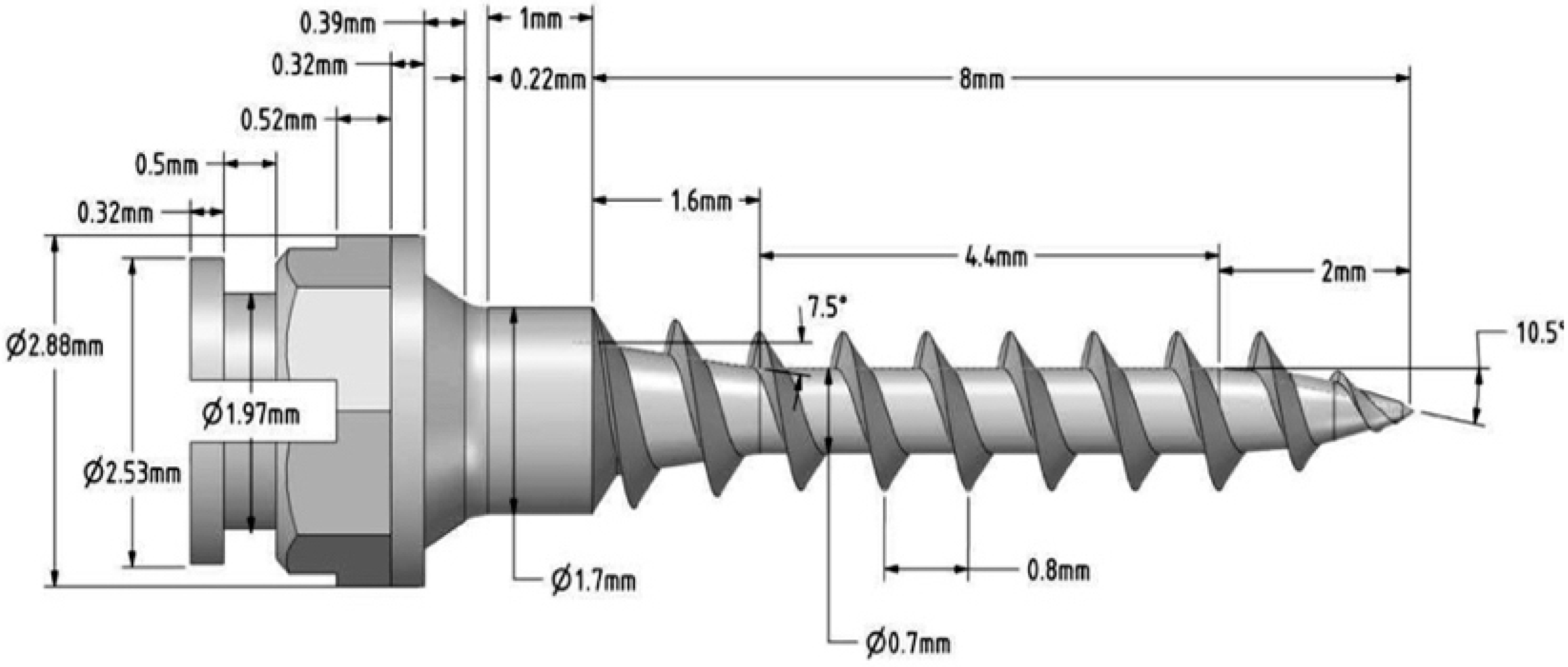
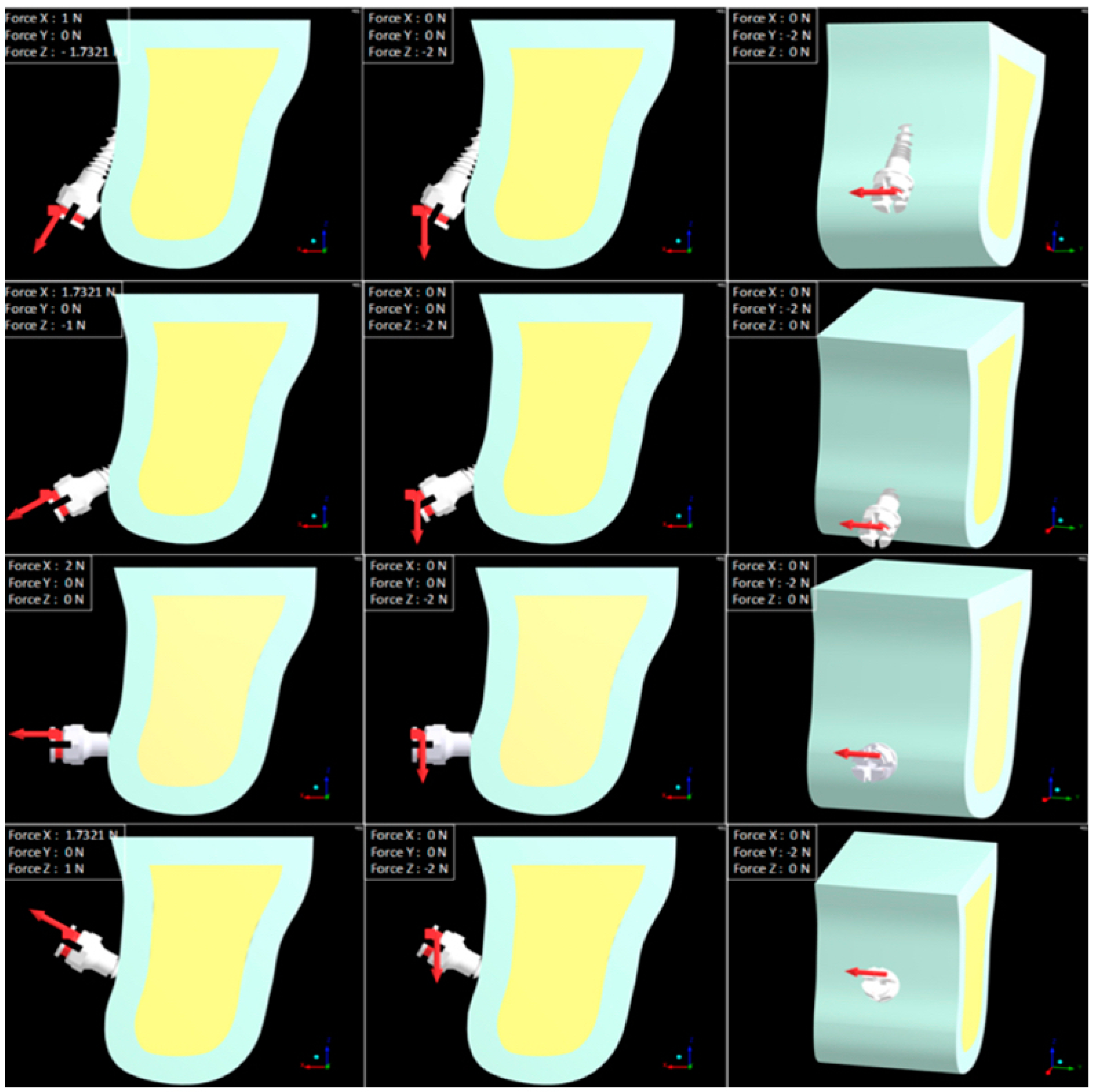
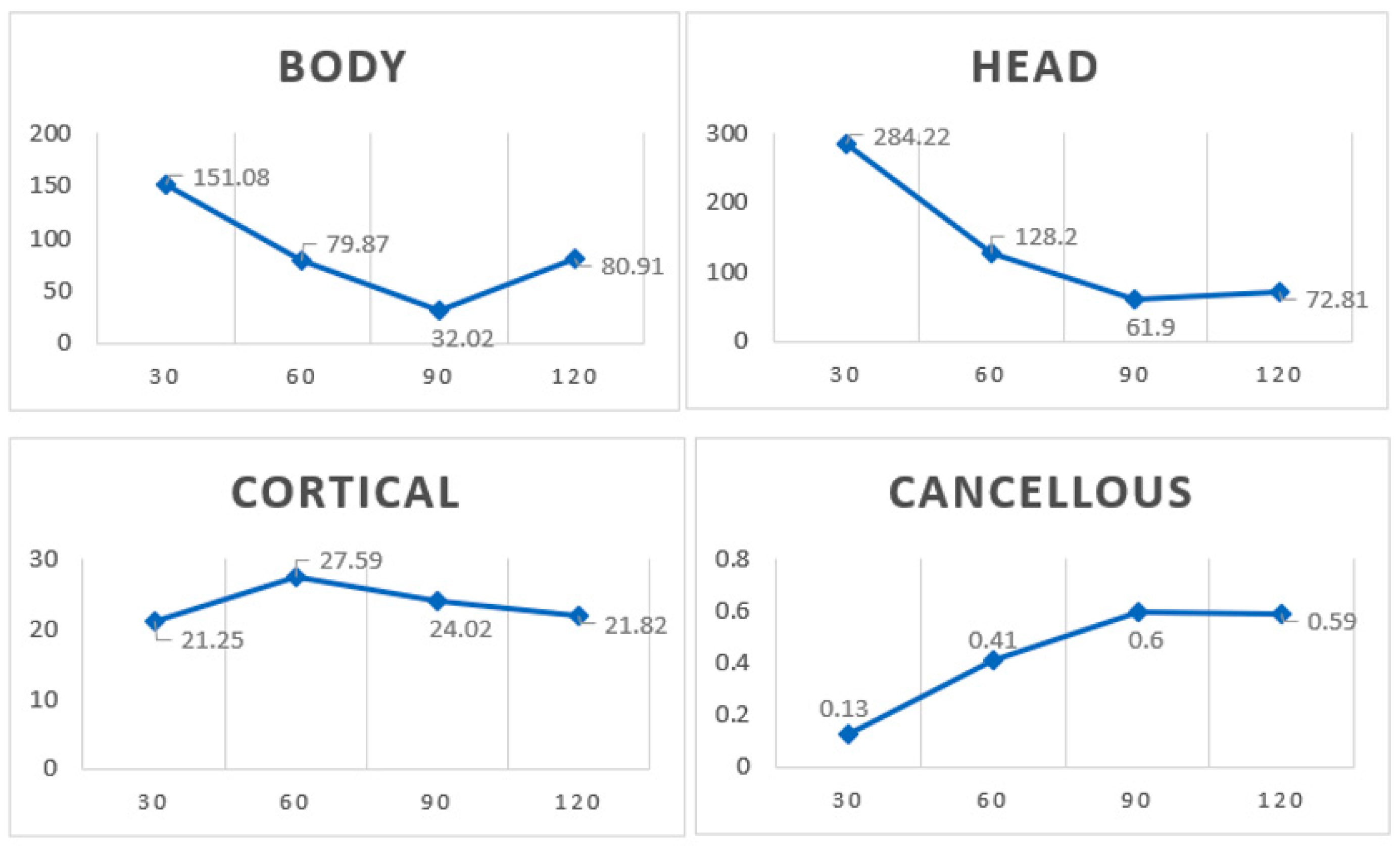
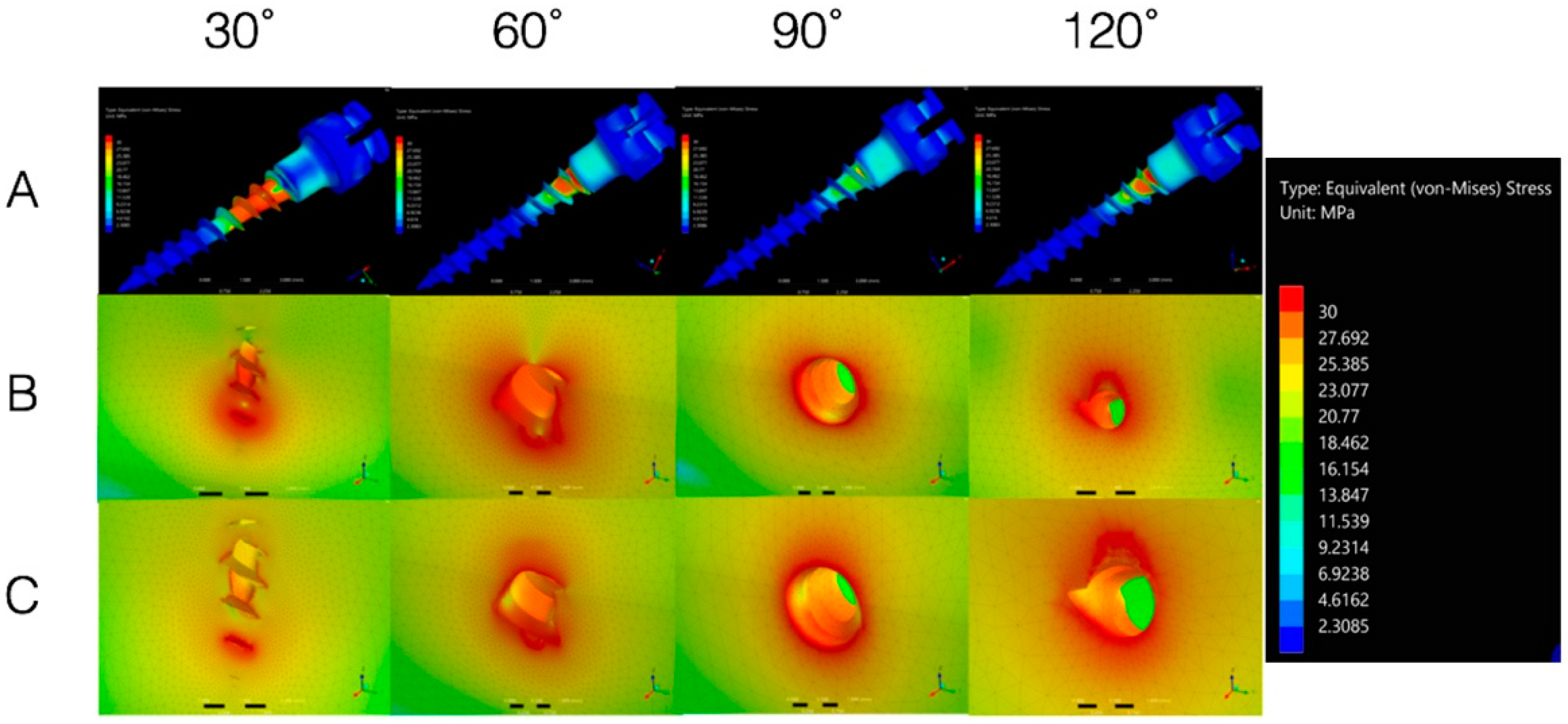
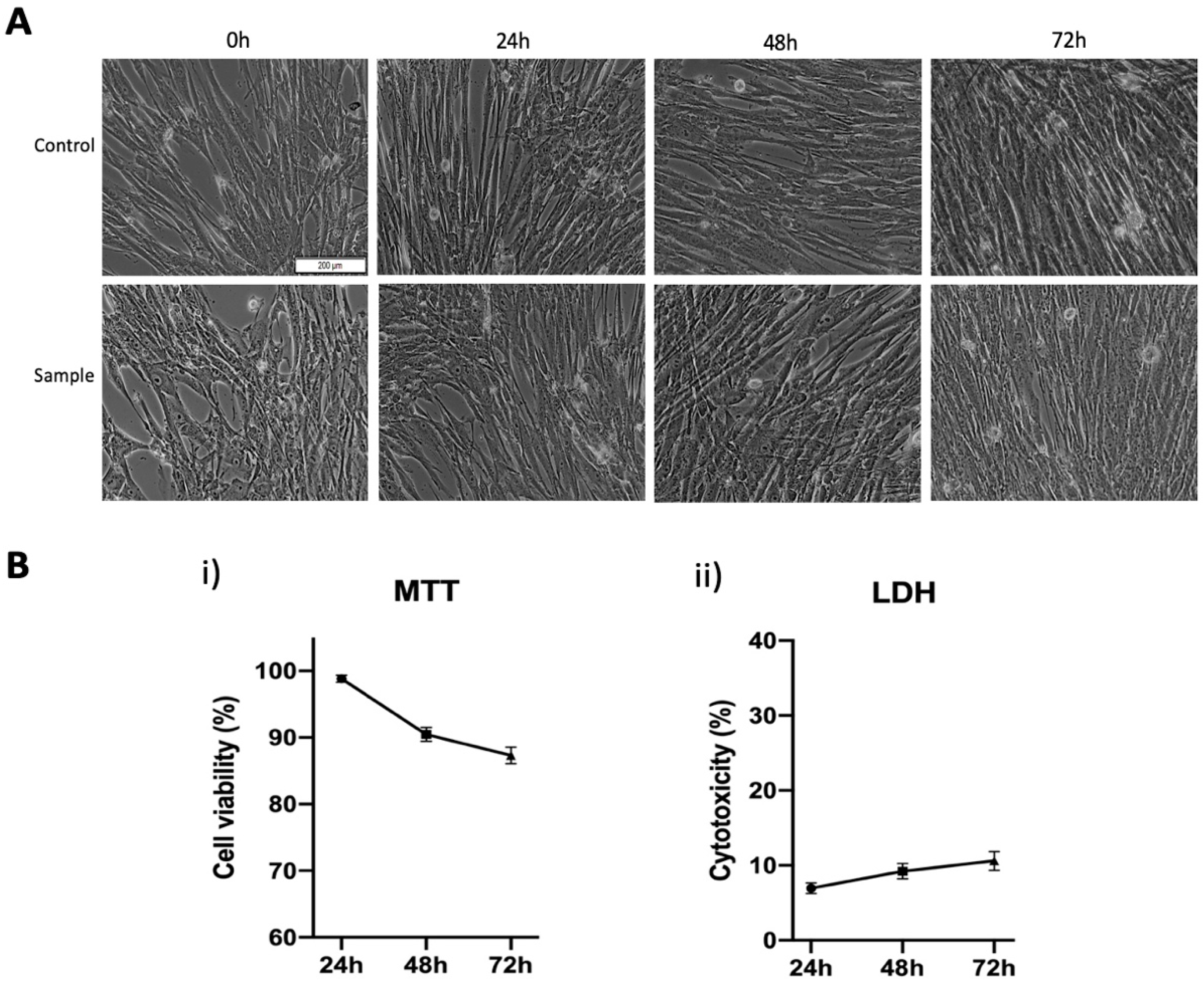

| Source | SS | Df | MSS | F | p-Value |
|---|---|---|---|---|---|
| Angle | 1763.792 | 3 | 587.931 | 517.457 | * |
| CBT | 436.389 | 2 | 218.194 | 192.04 | * |
| Error | 6.817 | 6 | 1.136 | ||
| Total | 49,425.37 | 12 |
| Source | SS | Df | MSS | F | p-Value |
|---|---|---|---|---|---|
| BODY | |||||
| Force Type | 24,597.64 | 1 | 24,597.64 | 1131.11 | 0.000 * |
| Angle | 43,644.5 | 3 | 14,548.16 | 668.99 | 0.000 * |
| Thickness | 1627.86 | 2 | 813.93 | 37.428 | 0.000 * |
| Force Type*Angle | 15,242.32 | 3 | 5080.77 | 233.64 | 0.000 * |
| Angle*Thickness | 5173.8 | 6 | 862.3 | 39.65 | 0.000 * |
| Force Type*Thickness | 32.576 | 2 | 16.28 | 0.75 | 0.512 |
| Error | 130.479 | 6 | 21.75 | ||
| Total | 263,725.8 | 24 | |||
| HEAD | |||||
| Force Type | 60,339.78 | 1 | 60,339.78 | 291.04 | 0.000 * |
| Angle | 189,062.1 | 3 | 63,020.68 | 303.97 | 0.000 * |
| Thickness | 3 | 2 | 6686.61 | 32.25 | 0.001 * |
| Force Type*Angle | 72,134.79 | 3 | 24,044.93 | 115.97 | 0.000 * |
| Angle*Thickness | 26,978.64 | 6 | 4496.44 | 21.69 | 0.001 * |
| Force Type*Thickness | 92.41 | 2 | 46.21 | 0.223 | 0.807 |
| Error | 1243.96 | 6 | 207.33 | ||
| Total | 812,244.9 | 24 | |||
| CORTICAL | |||||
| Force Type | 920.49 | 1 | 920.49 | 8.915 | 0.024 * |
| Angle | 118.25 | 3 | 39.42 | 0.382 | 0.77 |
| Thickness | 150.38 | 2 | 75.19 | 0.728 | 0.521 |
| Force Type*Angle | 1443.27 | 3 | 481.09 | 4.659 | 0.052 ** |
| Angle*Thickness | 747.89 | 6 | 124.65 | 1.207 | 0.413 |
| Force Type*Thickness | 140.81 | 2 | 70.41 | 0.682 | 0.541 |
| Error | 619.535 | 6 | 103.256 | ||
| Total | 17,692.23 | 24 | |||
| CANCELLOUS | |||||
| Force Type | 0.003 | 1 | 0.003 | 1.648 | 0.247 |
| Angle | 0.863 | 3 | 0.288 | 147.582 | 0.000 * |
| Thickness | 1.44 | 2 | 0.72 | 369.38 | 0.000 * |
| Force Type*Angle | 0.032 | 3 | 0.011 | 5.411 | 0.038 * |
| Angle*Thickness | 0.594 | 6 | 0.099 | 50.817 | 0.000 * |
| Force Type*Thickness | 0.008 | 2 | 0.004 | 2.029 | 0.212 |
| Error | 0.012 | 6 | 0.002 | ||
| Total | 7.486 | 24 |
| Sample | Irritation Score (IS) | Irritation Category |
|---|---|---|
| H2O | 0 | No irritation |
| SLS 0.5% | 18.3 | Strong irritation |
| Mini-implant | 0 | No irritation |
Publisher’s Note: MDPI stays neutral with regard to jurisdictional claims in published maps and institutional affiliations. |
© 2020 by the authors. Licensee MDPI, Basel, Switzerland. This article is an open access article distributed under the terms and conditions of the Creative Commons Attribution (CC BY) license (http://creativecommons.org/licenses/by/4.0/).
Share and Cite
Popa, A.; Dehelean, C.; Calniceanu, H.; Watz, C.; Brad, S.; Sinescu, C.; Marcu, O.A.; Popa, C.S.; Avram, S.; Nicolov, M.; et al. A Custom-Made Orthodontic Mini-Implant—Effect of Insertion Angle and Cortical Bone Thickness on Stress Distribution with a Complex In Vitro and In Vivo Biosafety Profile. Materials 2020, 13, 4789. https://doi.org/10.3390/ma13214789
Popa A, Dehelean C, Calniceanu H, Watz C, Brad S, Sinescu C, Marcu OA, Popa CS, Avram S, Nicolov M, et al. A Custom-Made Orthodontic Mini-Implant—Effect of Insertion Angle and Cortical Bone Thickness on Stress Distribution with a Complex In Vitro and In Vivo Biosafety Profile. Materials. 2020; 13(21):4789. https://doi.org/10.3390/ma13214789
Chicago/Turabian StylePopa, Adelina, Cristina Dehelean, Horia Calniceanu, Claudia Watz, Silviu Brad, Cosmin Sinescu, Olivia A. Marcu, Casiana Simina Popa, Stefana Avram, Mirela Nicolov, and et al. 2020. "A Custom-Made Orthodontic Mini-Implant—Effect of Insertion Angle and Cortical Bone Thickness on Stress Distribution with a Complex In Vitro and In Vivo Biosafety Profile" Materials 13, no. 21: 4789. https://doi.org/10.3390/ma13214789
APA StylePopa, A., Dehelean, C., Calniceanu, H., Watz, C., Brad, S., Sinescu, C., Marcu, O. A., Popa, C. S., Avram, S., Nicolov, M., & Szuhanek, C. A. (2020). A Custom-Made Orthodontic Mini-Implant—Effect of Insertion Angle and Cortical Bone Thickness on Stress Distribution with a Complex In Vitro and In Vivo Biosafety Profile. Materials, 13(21), 4789. https://doi.org/10.3390/ma13214789









